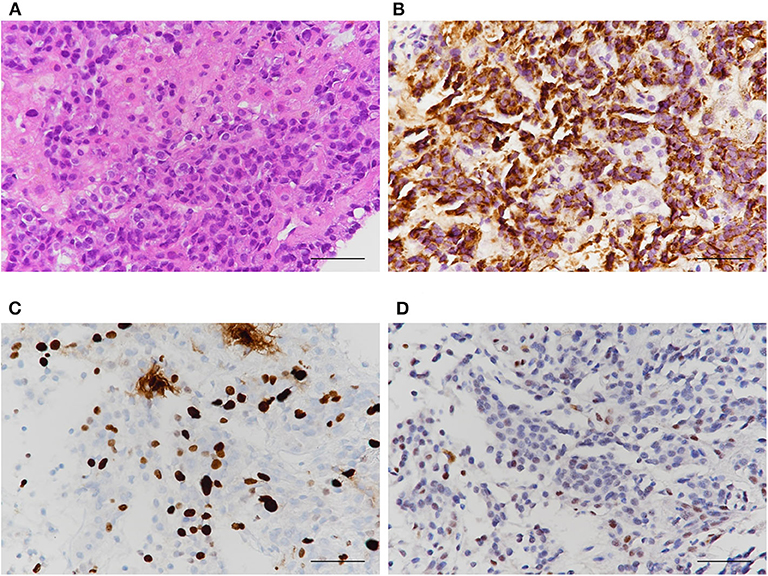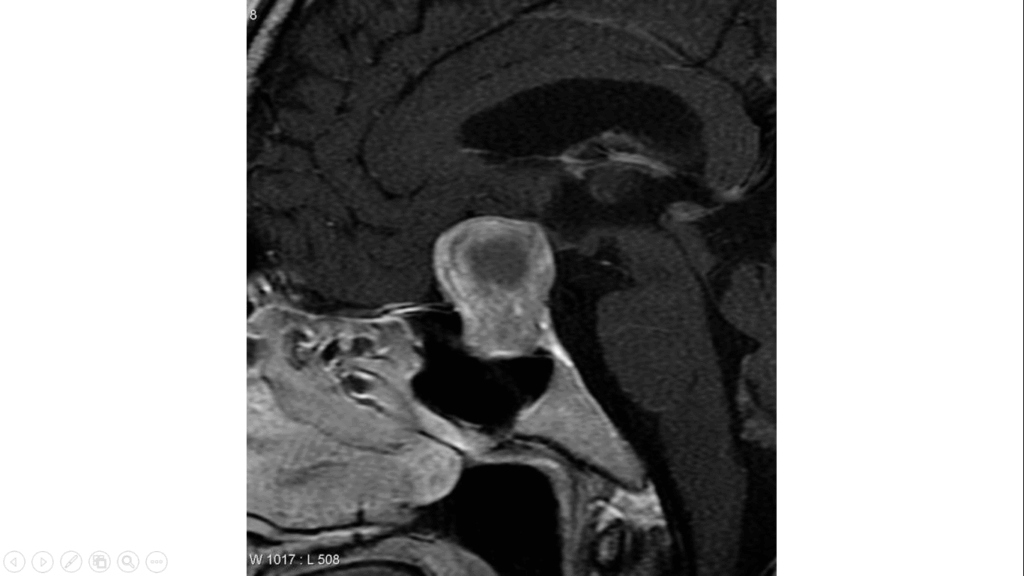A prolactinoma, often abbreviated as PRL, is a benign tumor that develops in the pituitary gland. This small gland, located at the base of the brain, plays a critical role in regulating various hormones in the body. A prolactinoma specifically causes an overproduction of prolactin, a hormone primarily responsible for milk production in women after childbirth. While this condition can affect both men and women, it is more commonly diagnosed in women of reproductive age. Understanding the causes, symptoms, and available treatments for prolactinomas is essential for managing this condition effectively.

What Is a Prolactinoma?
A prolactinoma is a type of noncancerous growth or adenoma that arises in the pituitary gland. The pituitary gland is often referred to as the “master gland” because it controls the release of several hormones that regulate bodily functions such as growth, metabolism, and reproduction. When a prolactinoma forms, it disrupts the normal functioning of the gland by causing excessive secretion of prolactin. Elevated levels of this hormone can lead to a range of physical and hormonal changes in the body.
Prolactinomas vary in size. Smaller tumors, known as microprolactinomas, are less than 10 millimeters in diameter, while larger ones, called macroprolactinomas, exceed this size. The size of the tumor often correlates with the severity of symptoms and the treatment approach required.
Causes of Prolactinoma
The exact cause of prolactinomas remains unclear, but researchers believe that these tumors arise due to genetic mutations or abnormalities in the cells of the pituitary gland. These mutations cause the cells to multiply uncontrollably, leading to the formation of a tumor. Below are some factors that may contribute to the development of this condition:
- Hormonal Imbalance: Disruptions in the balance of hormones within the body can trigger abnormal cell growth in the pituitary gland.
- Genetic Predisposition: Although rare, certain inherited conditions, such as Multiple Endocrine Neoplasia Type 1, increase the risk of developing prolactinomas.
- Environmental Factors: Exposure to certain medications, radiation, or other environmental triggers may play a role in the development of these tumors.
It is important to note that prolactinomas are not caused by lifestyle choices or external behaviors. They are medical conditions that require proper diagnosis and treatment.
Symptoms of Prolactinoma
The symptoms of prolactinomas differ between men and women due to the varying roles of prolactin in their bodies. In women, the condition often manifests through reproductive and hormonal changes, while in men, symptoms may be subtler and take longer to detect. Below are the common symptoms experienced by each gender:
Symptoms in Women
- Irregular Menstrual Cycles: One of the most noticeable signs in women is the disruption of menstrual periods. Periods may become irregular, infrequent, or stop altogether.
- Milk Production Without Pregnancy: Elevated prolactin levels can cause lactation even when a woman is not pregnant or breastfeeding.
- Fertility Issues: High prolactin levels interfere with ovulation, making it difficult for women to conceive.
- Vaginal Dryness: Hormonal imbalances can lead to reduced estrogen levels, resulting in dryness and discomfort.
- Headaches and Vision Problems: Larger tumors may press on nearby nerves or brain structures, causing headaches or visual disturbances.
Symptoms in Men
- Erectile Dysfunction: Men may experience difficulty achieving or maintaining an erection due to hormonal imbalances.
- Decreased Libido: A drop in testosterone levels can lead to a reduced sex drive.
- Gynecomastia: Some men may develop breast tissue enlargement due to hormonal changes.
- Infertility: Similar to women, men with prolactinomas may face challenges in fathering children.
- Fatigue and Weakness: Low testosterone levels can result in decreased energy and muscle strength.
Diagnosis of Prolactinoma
Diagnosing a prolactinoma involves a combination of clinical evaluation, blood tests, and imaging studies. If a patient presents with symptoms suggestive of elevated prolactin levels, a healthcare provider will typically order specific tests to confirm the diagnosis.
Blood Tests
A blood test is the first step in diagnosing this condition. It measures the level of prolactin in the bloodstream. Normal prolactin levels vary depending on factors such as age and gender, but consistently high levels may indicate the presence of a prolactinoma.
Imaging Studies
If blood tests reveal elevated prolactin levels, imaging studies such as magnetic resonance imaging (MRI) or computed tomography (CT) scans are performed to visualize the pituitary gland. These scans help determine the size and location of the tumor, which is crucial for planning treatment.
Additional Tests
In some cases, additional tests may be conducted to rule out other potential causes of high prolactin levels, such as pregnancy, kidney disease, or the use of certain medications. A thorough evaluation ensures an accurate diagnosis and appropriate treatment plan.
Treatment Options for Prolactinoma
The treatment for prolactinomas depends on the size of the tumor, the severity of symptoms, and the patient’s overall health. In many cases, medication is the first line of treatment, but surgery or radiation therapy may be necessary for more complex cases.
Medications
Dopamine agonists are the most commonly prescribed medications for treating prolactinomas. These drugs work by mimicking the effects of dopamine, a neurotransmitter that inhibits prolactin production. Examples include bromocriptine and cabergoline. These medications are highly effective in reducing prolactin levels, shrinking the tumor, and alleviating symptoms. Most patients respond well to medication, and the condition can often be managed without the need for surgery.
Surgery
Surgical intervention is considered if the tumor does not respond to medication, if the tumor is large and causing significant symptoms, or if the patient cannot tolerate the side effects of medication. The most common surgical procedure is transsphenoidal surgery, where the tumor is removed through the nose and sinuses. This minimally invasive approach reduces recovery time and complications.
Radiation Therapy
Radiation therapy is used as a last resort when medications and surgery fail to control the tumor. This treatment involves directing high-energy beams at the tumor to shrink it. However, radiation therapy is associated with long-term risks, such as damage to surrounding tissues and the potential for developing other hormonal deficiencies.
Lifestyle Adjustments
In addition to medical treatments, certain lifestyle adjustments can help manage symptoms and improve overall well-being. These include:
- Regular Monitoring: Patients should undergo periodic blood tests and imaging studies to monitor prolactin levels and tumor size.
- Healthy Diet and Exercise: Maintaining a balanced diet and staying physically active can support hormonal balance and overall health.
- Stress Management: Stress can exacerbate hormonal imbalances, so practices such as meditation, yoga, or counseling may be beneficial.
Complications Associated With Prolactinoma
If left untreated, prolactinomas can lead to several complications, including:
- Osteoporosis: Chronic elevation of prolactin levels can lead to reduced bone density, increasing the risk of fractures.
- Hypopituitarism: Large tumors may compress the pituitary gland, impairing its ability to produce other essential hormones.
- Vision Loss: Tumors pressing on the optic nerves can cause permanent vision problems if not addressed promptly.
Early diagnosis and treatment are crucial to preventing these complications and ensuring a better quality of life for individuals with prolactinomas.
Living With Prolactinoma
Managing a prolactinoma requires ongoing care and collaboration with healthcare providers. Regular follow-ups are essential to monitor the effectiveness of treatment and make adjustments as needed. Patients are encouraged to communicate openly with their doctors about any new symptoms or concerns that arise during the course of treatment.
Support groups and educational resources can also provide valuable assistance to individuals living with prolactinomas. Connecting with others who share similar experiences can offer emotional support and practical advice for navigating the challenges of this condition.





